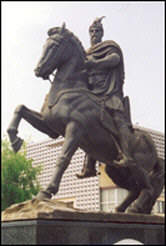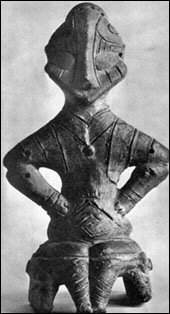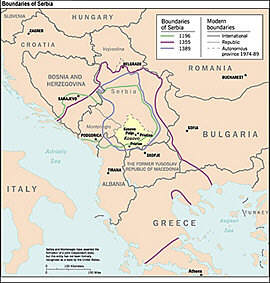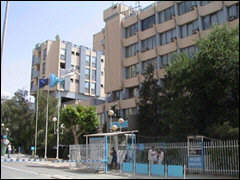 HISTORY HISTORY |
 A BRIEF HISTORY OF KOSOVO A BRIEF HISTORY OF KOSOVO |

The Famous Skender Beu
The earliest known inhabitants of Kosovo were the Illyrians and today's modern Albanian is said to have originated through the multiethnic marriages of Illyrians, Dardanians and other nomadic shepherds. Today many Albanians claim to be the direct descendents of the Illyrian people. In the 4th Century A.D. the region of Kosovo was conquered by Alexander the Great and became part of the Roman province of Dardania. The 6th Century introduced Slavic migration into the Balkans and witnessed the regional diffusion of the Illyrians, already known as Albanians, from the Adriatic regions into the areas that we now recognize as Kosovo and Albania. This period also saw the establishment of a defined Albanian language and culture. By the 12th Century most of the then Albanian region of Kosovo fell under the power and influence of Slavic tribes from the north.

Illyrian stone head found near Prishtina
By the year 1190 A.D. Kosovo by virtue of its location was regarded as the cultural and administrative center that fell under the control of the medieval State of Serbia that was controlled for over 200 years by the Nemanjic dynasty. Many Serbians refer to this period historically believing it determined the origins of "Old Serbia." A belief that they still value, regarding the rightful territories of Serbia today. Undisputedly the most significant date in the history of the region is 1389, when the Ottoman Turks defeated the Serbs in the famous "Battle of Polje." With victory's hand favoring the Turks, Kosovo became part of the Ottoman Empire, which encouraged many Albanians to return to the territory.
In 1489 the Ottomans took sovereignty in the Balkan region and due to continual conflict in the region, most of the Serbian population was gradually driven northwards. Historical records refer to this movement as the "Great Migration" which saw many Serbs settling in the northern urban center that what we now call and recognize as Belgrade. Throughout the late 19th and 20th century there was continued conflict between the Serbs and Ottoman Turks. It was not until after the Ottoman Turks were finally defeated in the Russo-Ottoman War of 1878 that the Serbian inhabitants of Kosovo were gradually able to regain control of most major urban centers and had totally reoccupied the area by 1912.
This historic defeat was a major catalyst for the first sprouts of Albanian nationalism. 1878 saw the creation of "The Prizren League" whose famous declaration echoes until present times.
"Just as we are not and do not want to be Turks, so we shall oppose with all our might to anyone who would like to turn us into Slavs, Austrians or Greeks, we want to be Albanians."
The creation of the League intended to strengthen and maintain Albanian control over Kosovo. The Ottoman Sultan was known to have supported the league, as it acted as an ally for influencing Islamic ideologies within the region, which helped him to counterbalance the strong Christian Orthodox and Slavic influences. However as the Ottoman Empire weakened, the Leagues became more independent and intolerant of Christianity, which generated fear amongst the Christian Albanians and naturally Serbian minorities residing in Kosovo.
In 1898 Russian interest in the region provoked strong concerns amongst the western and European powers. A new peace settlement was called for and later established that forced all Serbian troops to withdraw from the region and returned all Albanian inhabited land to the Ottomans.
Throughout the history of the Ottoman Empire, there consistently existed strong opposition to nationalistic tendencies wherever they arose. Over years of continual oppression the Kosovar Albanian's began to desire their voice of freedom and greater autonomy, however these desires under the Ottoman never became a reality they merely remained a dream.
In 1912 the first Balkan War took place. Montenegro, Serbia, Bulgaria and Greece attacked Albania. The Albanians that were allied with the Ottomans suffered severe losses. The Serbs who still harbored feelings for revenge from their defeat in the battle of Kosovo Polje in 1389, willfully burnt and destroyed Albanian houses as they pounded the enemy and reoccupied the land that they believed was once theirs and so brutally taken from them.
It was then that during a summit of Ambassadors in London, Sir Edward Grey the British Foreign Secretary at the time gave Serbia entire Sovereignty over Kosovo which they retained up until the war in 1999. At this time a large majority of the population within Kosovo was Albanian and this decision undoubtedly fuelled heated anti-Serbian sentiments in the region. After the second Balkan War in 1913, Serbia almost doubled its size gaining control over most of Macedonia.

|
Shortly after the Balkan Wars, World War I ensued and vicious fighting took place in Kosovo between Serbs and Albanians as each defended their allies and their rightful land. The Albanians along with their Austrian, Hungarian and Bulgarian Allies defeated the Serbs in what historically became known as "The Great Serbian Retreat" in 1915 where 100,000 Serbs were estimated to have lost their lives. As the War continued until 1918 favor's hand now fell upon the Serbian army that was supported by the Russians. This ruthless combination initiated relentless attacks upon the Albanians that permitted the Serb fighters to avenge the lives of their slaughtered families.
"The Kingdom of Slovenes, Croats and Serbs" or the newly formed Yugoslav State governed by Belgrade was established through the peace treaties of 1919-1920. The Yugoslav State that soon after changed its name to Yugoslavia consisted of Bosnia-Herzegovina, Montenegro, Macedonia. Kosovo still remained an integral part of Serbia, with 64% of its population being Albanian. In the newly created Yugoslav Kingdom with a population of 12 million, 400,000 of its citizens were Albanian.
In 1912 the Albanians of Kosovo called for the League of Nations to be established in order for them to help them reunite Kosovo with Albania. Ethnic conflict between Serbs and Albanians remained transparent and increasingly bitter. In the period 1918-1941 between the Two Great Wars, the Serbs unsuccessfully attempted to colonize Kosovo. In their attempts Albanian land was illegally appropriated and the Albanian population was asked to leave. However the Albanians viscously refused to give up their land and in 1931 had managed to maintain a 63% majority in Kosovo.
In 1939 during World War II, Germany occupied Serbia, Macedonia and Greece. Croatia and Bosnia-Herzegovina became Fascist states that were allied with Germany. Whilst most of Kosovo was controlled by Italy apart from the giant northern mining conglomerate of Trepca, that was then occupied by Germans. Resistance to the Germans was fierce and was mainly instigated by Loyalist Chetnicks. In 1943 a Croat Partisan, that was head of the communist party and known as Josip Broz, who was later known as Marshall Tito received the necessary support from the British Government to defeat the Germans. Marshall Tito consolidated his power as the communist ruler that managed to maintain Yugoslavia's unity for over 40 years.
In 1946 the then Yugoslav constitution did not grant territorial autonomy to Kosovo or recognize Albanian as a nationality. Despite repeated requests and complaints by the Kosovar Albanians there were only five nationalities that were recognized by the Yugoslav federation, Serb, Croat, Slovene, Montenegrin and Macedonian. Kosovo was only recognized as being under Serbian jurisdiction. The Albanian Kosovars were perceived in the eyes of Tito to be politically unreliable because of their wartime co-operation with the Axis powers.
In 1948 Tito ended all ties with Stalin and Yugoslavia ended diplomatic relations with Albania, which was still loyal to Moscow. The 1953 constitution further reduced the autonomy of Kosovo and many Albanians were repressed. 1956 saw a dramatic resurgence of Albanian nationalism, which was understandable during the circumstances and in 1963 the constitution placed what little that was left of the autonomy of Kosovo under Serbia authority.
In 1967 Tito made his first visit to Kosovo and purged the strong Serbian centralist and much-hated leader from Kosovo. In 1974 the constitution made Kosovo an autonomous province and by 1971 the Albanian population maintained a 74% majority. This further increased to 77% in 1981. Kosovo was becoming the economic vacuum of Yugoslavia and gradually became resented by other Yugoslav states such as Slovenia and Croatia as its exponential birth rates, low income and poorly educated Albanian population drained all government financial resources.
Following Titos death in1980 the Albanian population believed that they had lost their new protector, less then a year later Albanian riots and protests shook Kosovo as the Albanian population began demonstrating with the aim of forcing the Yugoslav Government to recognize the province as a federal republic. By the mid 1980's increasingly aggressive and extremist Albanian nationalistic behavior forced many Serbs to leave the region and the first Serbian protests started in 1986 calling for the de-Albanisation of Kosovo. These movements provoked extremist Albanians to create the "National Liberation party of Kosovo." Tension was further increased and brimming on boiling point when the Serbian government threatened to take away Kosovo's autonomy in 1987.
One of the most controversial dates in Kosovar history occurred in 1987 when a man by the name of Slobodan Milosevic visited Prishtina. Appointed as President of Serbia, Milosovic was strongly nationalistic and first came to Kosovo with the intention of rallying Serb crowds in protest to their suffering under the attacks and discrimination of the nationalistic Albanian majority. Milosovic as he addressed his Serbian comrades told them that "No force can now stop Serbia's unification." What was to ensue in the following years saw the resurgence of intense ethnic tension and repeated demonstrations lead by Albanian's encouraging the persecution of thousands of Serb minorities. Chaos engulfed the region which eventually lead to the Serbian constitution instigating measures to revoke the autonomy of Kosovo in 1989.

UN Headquarters Prishtina
In 1990 the Serbian government introduced the "program for Achieving Peace, Freedom and Equality in Kosovo" with the objective of obtaining a peaceful co-existence between Serbs and Albanians in the region. An angered Albanian population who had their own visions of an Independent Kosovo fiercely rejected this program. In 1990 the Serbian Government in September striped Kosovo of its autonomy, educational facilities and employment rights. In the years that followed, Kosovo experienced large scale civil disorder, rioting, protests, killings and unprecedented violence as the cultural and educational institutions of the Albanian people were revoked and the re-Serbanization of Kosovo occurred.
Violence, ethnic conflict and discrimination became the unfortunate realities of everyday life until war was officially and internationally declared in March 1999. This declaration is what lead to NATO'S intervention in June 1999. |

